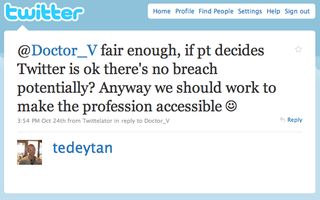Recently I wrote about how to handle things when patients try to engage doctors in the social media space. If you missed it you can read it here. If you want to save yourself 5 minutes consider the bottom line: Doctors and patients shouldn’t be discussing patient-specific issues in the social space.
I heard from Ted Eytan regarding my post:
The question is interesting: If the patient initiates the dialog is open discussion of a specific medical problem then okay?
I wish it were that simple.
It’s important to discriminate between what patients do on their own and what patients and physicians do together. Patients (lets call them people, shall we?) can effectively do as they please. You can live tweet your vasectomy or post your pathology report on your blog. Transparency is, after all, a badge of honor.
But when patients (I mean people) and doctors get together it gets a little trickier.
Here’s why:
If it’s okay with you is it okay with me? Open discussion of privileged medical information requires written consent. Healthcare attorneys have suggested that the initiation of communication by the patient implies consent. But don’t look for me to be the guinea pig when this one’s tested in the courts. Bottom line: permission to discuss is a little more complicated than you might think.
Documentation. Physicians bear the responsibility of documenting everything that happens between doctor and patient. From state medical boards to third party payers, physicians are obligated to get it all down.
More importantly, the documentation on most social platforms isn’t detailed enough for other medical professionals or auditors to follow what’s gone on between you and your caregiver. Let’s not forget that Twitter has a habit of disappearing after a couple of weeks.
What are you really saying? Then there’s the issue of assessing a febrile infant in under 140 characters. If you’ve ever cared for the sick you know that sorting out problems isn’t always easy. Assessment of even the simplest medical issue requires clear responses to clearly understood questions. Current technology isn’t built for this kind of exchange (HelloHealth not included).
It just isn’t smart. Sharing detailed personal health information in a public forum isn’t smart. Sure the tongue-in-cheek comment about your ingrown toenail isn’t likely to create problems. Discussions about anything more serious isn’t for others to hear. Keep in mind that everyone from employers to insurance companies are tuning in to what you have to say.
So do we shutter the idea of any interaction between doctors and patients? Absolutely not. E-patients and physicians need to be together socially. This only helps our relationship. This is where the real power of social health lies.
There are plenty of very accessible and private formats by which you can communicate with your doctor. And if your doctor isn’t available by those means it’s really unlikely you’ll find her rootin’ around on Twitter.
